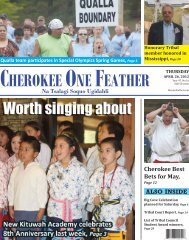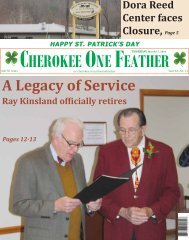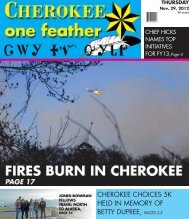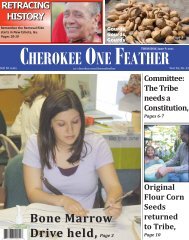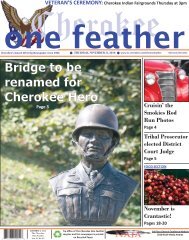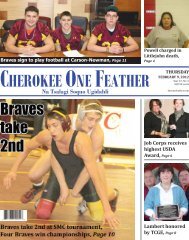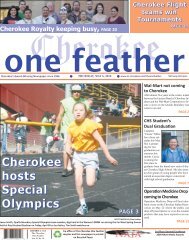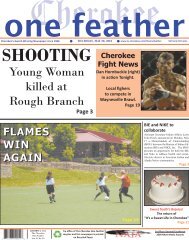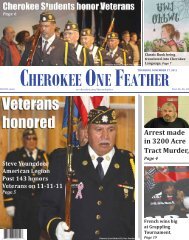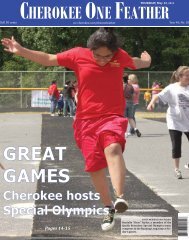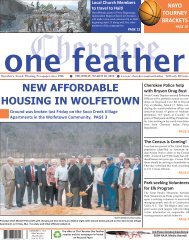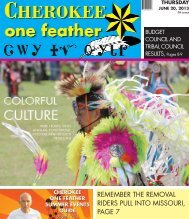July 4, 2013 - The Cherokee One Feather
July 4, 2013 - The Cherokee One Feather
July 4, 2013 - The Cherokee One Feather
Create successful ePaper yourself
Turn your PDF publications into a flip-book with our unique Google optimized e-Paper software.
8<br />
THURSDAY, JULY 4, <strong>2013</strong><br />
cherokee one feather/na tsalagi soquo ugidahli<br />
You could<br />
travel the world<br />
President Obama forms<br />
White House Council on<br />
Native American Affairs<br />
in search of<br />
exotic peoples.<br />
Or, they could all<br />
come to you.<br />
<strong>The</strong> Festival of Native Peoples<br />
<strong>July</strong> 12–13 from 11am –9pm.<br />
$10 daily at the event or at Visit<strong>Cherokee</strong>NC.com.<br />
Interact with what's widely considered the finest<br />
showcase of native customs in the Southeast. Immerse<br />
yourself in dance, song, food, and celebration, with<br />
tribes from Aztec to Zuni, at the Festival of Native<br />
Peoples: two dizzying days of cultural delights.<br />
By SCOTT MCKIE B.P.<br />
ONE FEATHER STAFF<br />
President Obama officially established<br />
the White House Council<br />
on Native American Affairs on<br />
Wednesday, June 26. In an executive<br />
order establishing the Council,<br />
he states its purpose is “to promote<br />
and sustain prosperous and resilient<br />
Native American tribal governments”.<br />
Membership on the Council will<br />
consist of the Secretary of the Interior<br />
serving as chair along with the<br />
heads of 30 government agencies<br />
such as the Department of Defense,<br />
Department of State, Department of<br />
Justice and others.<br />
Secretary of the Interior Sally<br />
Jewell formally announced the formation<br />
of the Council at NCAI’s<br />
Mid-Year Conference in Reno, Nev.<br />
on Thursday, June 27. “This Council<br />
is an important step in this Administration’s<br />
efforts to further strengthen<br />
its commitment to advancing tribal<br />
self-determination. <strong>The</strong> Council will<br />
help ensure that the federal family<br />
has regular and meaningful engagement<br />
on the key issues that impact<br />
Indian Country so that we can be<br />
more effective when it comes to supporting<br />
prosperous and resilient<br />
tribal communities.”<br />
NCAI president Jefferson Keel<br />
praised the Council’s formation in a<br />
statement on June 26, “President<br />
Obama’s Executive Order represents<br />
a very strong step forward to<br />
strengthen our nation-to-nation relationship.<br />
<strong>The</strong> Council has been a<br />
top priority of tribal leaders from the<br />
earliest days of the Obama Administration.<br />
It will increase respect for<br />
the trust responsibility and facilitate<br />
the efficient delivery of government<br />
services.”<br />
During a media teleconference<br />
on June 27, Assistant Secretary for<br />
Indian Affairs Kevin Washburn said,<br />
“<strong>The</strong> Tribal Nations Conference was<br />
established four years ago. That was<br />
a really important evolution in federal<br />
policy towards American Indian<br />
tribes. This is the next step in that<br />
evolution.”<br />
He added, “I think we are doing<br />
more for Indian Country than any<br />
administration ever has, but we need<br />
to communicate more.”<br />
According to Assistant Secretary<br />
Washburn, the Council will have<br />
quarterly meetings with the cornerstone<br />
being the Tribal Nations Conference.<br />
Secretary Jewell related that<br />
the first Council meeting is scheduled<br />
for later this summer.<br />
Jodi Gillette, senior policy advisor<br />
for Native American Affairs on<br />
the White House Domestic Policy<br />
Council, told reporters during the<br />
teleconference, “<strong>The</strong> President is<br />
firmly committed to building the nation-to-nation<br />
relationship and making<br />
that a cornerstone of how the<br />
administration deals with Indian<br />
tribes.”<br />
She said communication is a key.<br />
“We need to do more. We need to do<br />
it better. At the end of the day, it’s<br />
really about supporting self-determination<br />
and self-governance because<br />
we know that’s what works.”<br />
<strong>The</strong> mission of the Council has<br />
been outlined as follows, “<strong>The</strong> Council<br />
shall work across executive departments,<br />
agencies, and offices to<br />
coordinate development of policy<br />
recommendations to support tribal<br />
self-governance and improve the<br />
quality of life for Native Americans,<br />
and shall coordinate the United<br />
States Government’s engagement<br />
with tribal governments and their<br />
communities.”



